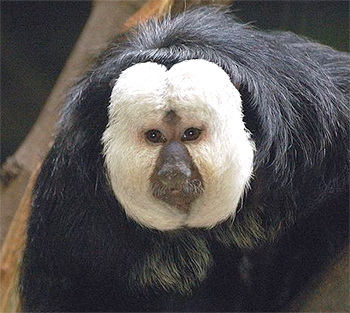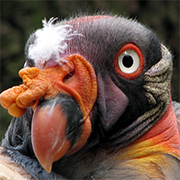Brevard Zoo Welcomes New White-Faced Saki Babies
By Space Coast Daily // March 21, 2014
creatures include White-faced saki monkey and a King Vulture
ABOVE VIDEO: White-faced saki monkeys are native to northern and central South America and are not threatened in the wild. They forage for honey, leaves and flowers and prey upon small mammals and birds. (James Bolton Video)
BREVARD COUNTY, FLORIDA — Brevard Zoo welcomed a female White-faced saki monkey (Pithecia pithecia), born Feb. 27 to mom, Chuckie, and dad, Yuki, after a gestation period of about 170 days.

This is their third offspring. Chuckie came from Sacramento Zoo in October 2007 and is 10 years old. Yuki came from Denver Zoo in October 2007 and is 22 years old.
The newest addition to the family joins her two big sisters, Watson, born April 27, 2012 and Suni, born May 17, 2013. For the first few months, she will hold on tightly to mom.
As she gets older, her big sisters will help carry her around. It is helpful for the older siblings to participate in her development. This will give them experience for when they have babies of their own to care for.
With such young, energetic offspring, this exhibit is quite active. Often you will see the girls bounding though the air from tree to tree. However, dad, Yuki, stays out of the limelight, preferring solitude at the back of the exhibit.

According to the Zoological Information Management System (ZIMS), there are 441 individuals in 126 zoological institutions.
There are very few studies done in the wild on this species due to the size of their home ranges and their inability to get used to humans even after hundreds of hours observation.
White-faced saki monkeys are native to northern and central South America and are not threatened in the wild. They forage for honey, leaves and flowers and prey upon small mammals and birds.

Brevard Zoo also has welcomed a King vulture chick (Sarcorhamphus papa), born Feb. 10 to mom, Queenie and dad, BB King, after a 54 day incubation period. This is their third successful hatching. The gender of the offspring is not known at this time. Queenie came from Cameron Park Zoo in May 2006 and is 15 years old. BB King came from Natural Encounters, Inc. in February 2009 and is also 15 years old.
The keepers have doubled the feeding of the vulture parents since the chick has hatched. BB King and Queenie share responsibility in feeding and caring for their chick.

They can be seen putting food directly into the chick’s mouth, or on the ground in front, encouraging it to eat on its own. Still unsteady on its feet, the chick will “waddle” to a new area and sit and wait for food. King vulture chicks are not very active for the first few months as they are growing so quickly, and are pretty bottom heavy. The fluffy white down that covers the chick, except on its head, neck and crop, will stay for the first few months as the black juvenile feathers come in.
The White-faced saki monkey and the King vulture chick can now be seen on exhibit in the La Selva area of the Zoo.











